Bollen was the birthplace of Bruno Zee, and the ancestral home of the Seekamp family.
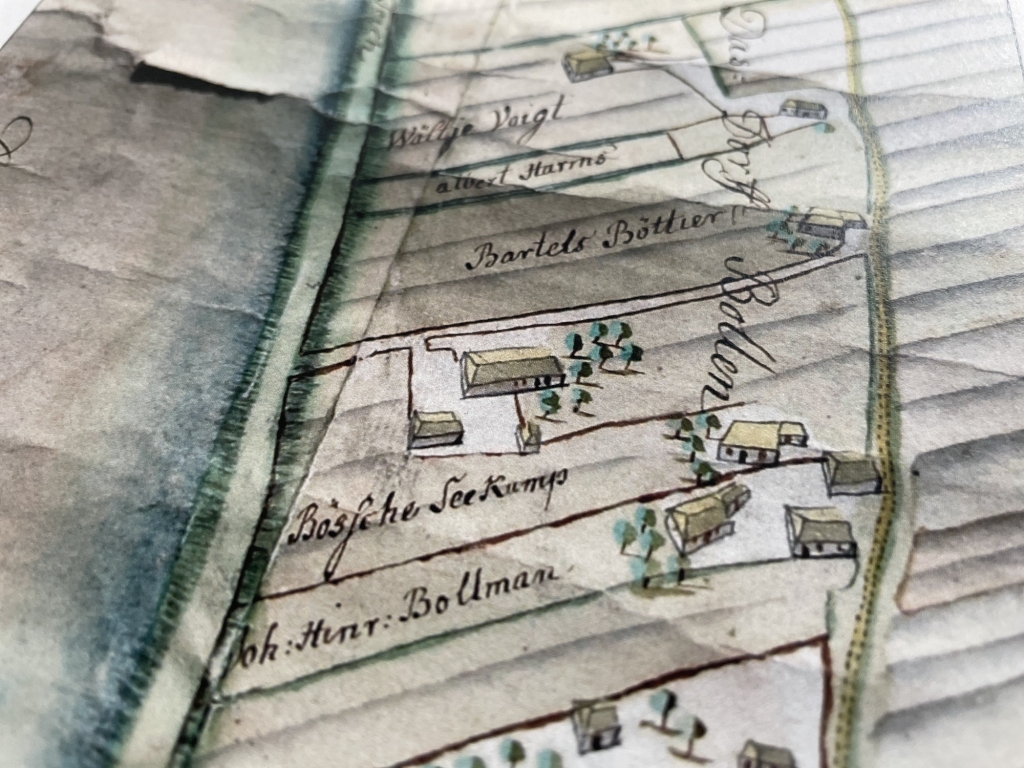
This little hand drawn map of the village of Bollen comes from the Zehntkarte of 1744, showing the land owned by Bösche Seekamp (Bruno’s brother). The full map is interesting, as it gives us a complete picture of the village of Bollen in 1744.

Johann Meijer. Bruno sailed on the Hogenes in 1721 with Hinrich Meijer from Bollen, and married Anna Margaretha Meijer. It could be that one or both are connected here.
Seekamps in Bollen
The Niedersachsen Archiv has mentions of Seekamps in the 1600’s. Listed as follows.
Weinkaufsbrief Bösche Seekamp, 1639 Alte Weinkaufsbriefe und Verträge zu Gütern und Einkünften der bremischen Domstruktur (überwiegend Abschriften und Konzepte) – includes Weinkaufsbriefe des Kanzlers Esais von Pufendorf für die Dorfschaft Hastedt vom 9. Juli 1681 wegen des Korn- und Schmalzehnten ebenda sowie für die Dorfschaft Schwachhausen vom selben Tag wegen des Kornzehnten ebenda (mit Anlage: Meierbrief für Claus Klatte zu Schwachhausen vom 4. April 1640); Weinkaufsbrief des Baumeisters Daniel Sarnighausen in Bremen für Lüer Selte vom 28. Dezember 1681 wegen eines Kornzehnten vor Hastedt (mit Anlage: Weinkaufsbrief für den Vorwirt Wöltje Seekamp vom 30. Juli 1639); Weinkaufsbrief Sarnighausens für Johann Selte aus Hastedt vom 31. Dezember 1681 wegen eines vollen Hofes ebenda. [>]
—
Levecke (Leffke) Pagelmann (Bagelmann), gewesener Bürger und Bäcker in Bremen, vom 7. April 1696 wegen des in einem Wirtshaus der Vorstadt Bremen bei einer Schlägerei getöteten Borchert von Bremen, mit nachfolgender Untersuchung der Sache durch den Bremer Etatsrat Christoph Heinrich von Weissenfels; weiteres Schutzgesuch Pagelmanns vom 20. Mai, Regierungsverfügung vom 5. Juni wegen vorheriger Kautionsstellung durch Pagelmann, Kautionsleistung für diesen durch Daniel Löddiges aus Hastedt, Johann Hinrich Schmidt und Brüning Seekamp, beide Bürger und Färber vor dem Ostertor in Bremen, vom 13. August, sowie Geleit- und Schutzbrief der Regierung für Pagelmann vom 26. August 1696 [>]
—
Dispenserteilung gegen Gebühr zur Eheschließung des Viehhirtensohnes Hinrich Meyer zu Daverden mit Mette Seekamp, Tochter der Schwester seines Vaters, auch Bericht des Etatsrats Christoph Heinrich von Weissenfels als Gogräfe des Gerichts Achim dazu (1712) [>] [A little early to be Bruno’s friend Hinrich Meyer, but possible]
—
Akten der Vorinstanz: Justizkollegium, 1691 – 1694, Hermann Meineke, Johann Seekamp, Dietrich Martens zu Uphusen, sowie Brun Seekamp und Reimer Frerichs zu Bollen vs. die Einwohner zu Uphusen in pcto gemeiner Weide im Fredebrock und deren Betreibung (4 cm, 198 Bl.) [>] [Court case files for tribunal between villagers of Bollen vs villagers of Uphusen, over access to shared pastoral land. Could have interesting information about Brun Seekamp – likely Bruno’s grandfather (1641-1717)] Details of this case:
- Auseinandersetzung um die gemeine Weide im Fredebrock und deren Betreibung: Streitig waren die Weiderechte im Fredebrock. Kl. behaupteten, dass das Bruchland seit jeher von den Parteien als gemeine Weide genutzt worden war, Bekl. wiederum gestanden der Dorfschaft für ihr Vieh nur die Vor- und Nachweide im Bruch zu und beanspruchten das Gras, das im Sommer wuchs, ausschließlich für sich. Bekl. wandten sich an den Richter zu Achim, der Kl. befahl, sich zukünftig der Weide zu enthalten und den Schaden, der Bekl. durch ihre Viehweide entstanden war, zu erstatten. Als diese der Anordnung nicht nachkamen, pfändete er sie. Nach erfolgter Schätzung des entstandenen Schadens befahl der Richter Kl. am 30.09.1691, Bekl. dementsprechend zu befriedigen. Kl. beschwerten sich beim Justizkollegium über die Pfändung, erkannten darüber hinaus das Gericht zu Achim nicht als zuständiges Gerichtsforum an, und das Justizkollegium erließ am 05.12.1691 und 13.01.1692 Strafmandate an den Richter zu Achim, die Pfändung aufzuheben und sich der Sache, die an das große Holzgericht verwiesen wurde, zu enthalten. Das Holzgericht hatte mittlerweile Bekl. am 01.12.1691 die Beweisführung auferlegt, der sie nicht nachkamen. Auf Klage der Dorfschaft Uphusen erkannte das Justizkollegium am 05.04.1693, dass die vom Gericht zu Achim erkannten Verordnungen von Kl. anerkannt worden und somit rechtsgültig seien. Sie hätten Bekl. nicht vor dem Holzgericht belangen dürfen. Bekl. wurden nunmehr im Besitz des Weiderechts geschützt. Dagegen appellierten Kl. an das Tribunal und baten – Controversy over the common pasture in Fredebrock and its operation: The grazing rights in Fredebrock were disputed. The plaintiffs claimed that the Bruchland had always been used by the parties as common pasture, the defendants, in turn, only allowed the villagers to graze their cattle on the pre- and post-pastures in the Bruch and claimed the grass that grew in the summer exclusively for themselves . The defendants turned to the judge, Achim, who ordered the plaintiffs to refrain from grazing in the future and to compensate the plaintiffs for the damage caused by their cattle grazing. When they did not comply with the order, he seized them. After the damage had been estimated, the judge ordered the claimant to be satisfied accordingly on September 30, 1691. The class complained to the judiciary about the garnishment, also did not recognize the court in Achim as the competent court forum, and the judiciary issued penal mandates on December 5, 1691 and January 13, 1692 to the judge in Achim to lift the garnishment and deal with the matter, who was referred to the great wood court. The timber court had meanwhile imposed the burden of proof on the defendant on December 1, 1691, which they did not comply with. On April 5, 1693, the judiciary recognized that the ordinances recognized by the court in Achim had been recognized by the class and were therefore legally valid. You should not have prosecuted the defendant before the timber court. Defendants were now protected in possession of the grazing right. On the other hand, the class appealed to the tribunal and asked …
- zu erkennen, dass die Sache an das Holzgericht als zuständigem Forum zu weiterer Ausführung zu verweisen sei, dagegen die Verfügungen des Gerichts zu Achim aufzuheben und Kl. beim Besitz der Weide so lange zu schützen seien, bis Bekl. den Beweis geführt hätten. Das Tribunal nahm den Prozess am 19.09.1693 an. Am 20.12.1694 legten die Gutsherren der Kl. eine Assistenzschrift zu Gunsten ihrer Meier vor, die das Tribunal am 21.12. zur Miterwägung annahm. Am 08.04.1695 bestätigte das Tribunal das vorinstanzliche Urteil. Auf Gesuch der Bekl. wurde die Sache am 07.05.1695 zur Vollstreckung an das Justizkollegium zurück verwiesen. Das am 18.05.1695 von Kl. gegen das Urteil vorgelegte Gesuch um “Restitutio in integrum” nahm das Tribunal am 21.05.1695 zur Erwägung an und bestätigte am 21.10.1695 das vorige Urteil. Den Gutsherren der Kl. blieb es allerdings vorbehalten, ihr “petitorium” gegen Bekl. beim bremischen Hofgericht anzubringen und zu beweisen, dass der fragliche Ort seit langer Zeit der gesamten Dorfschaft Uphusen als gemeine Weide gedient und das Dorf-Vieh ohne Unterschied den ganzen Sommer hindurch dort geweidet habe. to recognize that the matter should be referred to the timber court as the competent forum for further elaboration, while the orders of the court in Achim should be revoked and the plaintiffs in possession of the willow should be protected until the defendants have provided evidence. The tribunal accepted the process on September 19, 1693. On December 20th, 1694, the landlords of the clerk presented an assistance document in favor of their Meier, which the tribunal received on December 21st. accepted for consideration. On April 8, 1695, the tribunal confirmed the judgment of the lower court. At the request of the defendant, the matter was referred back to the judiciary for enforcement on May 7, 1695. On May 18, 1695, the tribunal accepted the request for “Restitutio in integrum” submitted by the plaintiff against the judgment on May 21, 1695 and confirmed the previous judgment on October 21, 1695. However, the landlords of the class were left with the right to file their “petitorium” against the defendant at the Bremen court court and to prove that the place in question had long served the entire Uphusen village community as a common pasture and that the village cattle indiscriminately the whole summer have grazed through there.
—
Gesuch des Bremer Bürgers Brüning Seekamp an die Regierung vom 2. März 1718 um Bemeierung mit dem vor dem Ostertor gelegenen Kohlland des verstorbenen Hinrich Dammann (mit Anlage: Protokoll vom 7. Dezember 1693 über die Abtretung des entsprechenden Kohllandes von der Witwe des Carsten Otte an Seekamp); nachfolgendes Regierungsmandat an den Baumeister Hinrich Rehboom vom 3. März wegen Beweislegung durch Seekamp und Berichterstattung; Bericht Rehbooms vom 11. März (mit Anlage: Weinkaufsschein des Superintendenten Dr. Bernhard Oelreich, damaliger Administrator der Struktur, für Hille Ötgen, Nichte des Carsten Otte, und deren künftigen Ehemann vom 18. Februar 1678 über die Kohlländerei); Notifikation des Berichts an Seekamp vom 14. März; Gegenanzeige Seekamps an die Regierung vom 17. März, mit dem Angebot der Zahlung des doppelten Weinkaufs und Zinses (mit Anlage: Weinkaufsschein Oelreichs von 1678, mit beigefügter Abmessung der Länderei) Petition by the Bremen citizen Brüning Seekamp to the government of March 2, 1718, for the use of the cabbage land in front of the Easter Gate belonging to the deceased Hinrich Dammann (with attachment: Protocol of December 7, 1693 on the assignment of the corresponding cabbage land from Carsten Otte’s widow to sea camp); Subsequent government mandate to the master builder Hinrich Rehboom of March 3 for evidence by Seekamp and reporting; Rehboom’s report of March 11 (with attachment: wine purchase certificate from Superintendent Dr. Bernhard Oelreich, then administrator of the structure, for Hille Ötgen, niece of Carsten Otte, and her future husband of February 18, 1678 about the Kohlländerei); Notification of report to Seekamp on March 14; Seekamp’s counter-advice to the government dated March 17, with the offer to pay double the wine purchase and interest (with enclosure: Oelreich’s wine purchase certificate from 1678, with attached dimensions of the estate) [>]
The surrounding towns are Achim, Arbergen, Clüverswerder, Verden.
Achim
The plague in Achim, 1712
The ‘Black Death‘, or the Pest in German, resurfaced in Europe many times after the initial pandemic in 1350. With the Great Northern War, the Pest came again to Northern Germany, and reached its peak in Achim and Bollen in the second half of 1712. In Achim, one sixth of the population, 50 out of 300 people, died. Houses of some of the infected were burned to the ground in an attempt to rid the village of the virus. [source: Geschichtswerkstatt Achim]
Bruno Zee was 15 when this happened, and it would have been a traumatic experience. We can draw parallels with the Covid-19 epidemic of 2020, but the lethality and contagion of the Pest was far higher.
The big picture – what was happening in Achim around 1712?
Source, translated from German:
Since the end of the Thirty Years’ War, large parts of northern Germany have belonged to the Kingdom of Sweden, the major Protestant and protective power. Even the traditional office of Achimer Gohgrefen was carried out by four members of the Swedish noble family of Königsmarck from 1648 to 1694. The old warhorse Field Marshal and Governor General Hans Christoph Graf von Königsmarck (1648 – 1663) was followed by his sons, Major General and Vice Governor Konrad Christoph Graf von Königsmarck (1663 – 1672), and Field Marshal Otto Wilhelm Graf von Königsmarck (1672 – 1686) and his Grandson Philipp Christoph Graf von Königsmarck (1686 – 1694), who died under mysterious circumstances after an extramarital liaison with the Hanover spa princess Sophie Dorothea. The Swedish budget councilor in Bremen, Christoph Heinrich von Weissenfels, succeeded him as Gohgrefen. Only from 1675 to 1679 did Achim come under the Catholic influence of the Bishop of Münster, the so-called Muenster period, during the execution against Sweden. The Duchies of Bremen and Verden were occupied by the troops of the Bishop of Münster, the chroniclers unanimously describe these years as the most terrible of those decades
Sweden’s rule in northern Germany ended at the beginning of the 18th century as a result of Sweden’s Great Northern War against Denmark, Russia, Saxony-Poland and others (1700 to 1721). Only Stade as a fortress and residence city had not been abandoned by the Swedes without a fight. After long shelling by the Danish opponent of the war, Stade finally fell on September 6, 1712 and was occupied by the Danes together with large parts of the Duchy of Bremen. Also in 1712, the Duchy of Verden and from the Duchy of Bremen the Amt Ottersberg were occupied by the Elector Georg Ludwig of Hanover, even with the consent of the Governor General of Sweden. The Hanoverian endeavor to let the duchies under Swedish rule pass into Welfian possession, even against the resistance of the third party, Denmark, and thus to extend Hanover’s sphere of influence to the mouths of the Elbe and Weser rivers. After Verden’s occupation by Hanover (1712), after tough negotiations with the parties involved, the purchase of the Duchy of Bremen by the Danes (1715) for around 800,000 Reichsthalers and finally the final acquisition of both duchies by the Swedes (1719) for 1,090,000 Reichsthalers. Thus the Achimers became Hanoverians, better subjects of the Elector of Hanover, as the vernacular called the Welfish Elector of Braunschweig-Lüneburg.
In 1712 Achim was in tension between the claims to power of Sweden, Denmark and the strengthening Electorate of Braunschweig-Lüneburg (Hanover) under the Welfish Elector Georg Ludwig, who was in personal union as George I King of Great Britain in 1714. A time of change in the European state system.
The plague comes closer to Achim
Source, translated from German:
As a result of the military movements during the Northern War, the plague was introduced into eastern Central Europe in the summer of 1709. Prussia, Poland and Pomerania, most heavily Danzig and Königsberg, were already affected. 9,612 people are said to have died in Gdańsk from August 24 to September 21, 1709. According to the Council Regulation of August 18, 1709, only strangers and goods were allowed to come to Bremen, for which it can be proven by written evidence that they came from places not affected by the plague. However, these provisions were apparently neglected or checked.
The Council of the City of Bremen therefore repeated the ordinance on January 22, 1710, in a more stringent form. At the Bremen plague researcher Klaus Schwarz we read: “Every stranger must present a health certificate. Jews, gypsies” and other rabble “should be completely excluded, old clothes, bedding, hair, smoke and fur, wool, flax and hemp as well as feathers in which the plague easily adheres and is propagated “But experience has shown that the plague lost its horror in the winter. Public compliance with the provisions remained limited. They acted more like a mandatory exercise by the Council to appease foreigners.”
In the summer of 1710, however, bad news came again from Western and Western Pomerania, Poland, Prussia and Silesia. The Swedish government of the Duchies of Bremen and Verden stationed positions at the end of November 1710 to protect the Duchies in Vegesack, Hastedt, Achim, Langwedel, Scheeßel and Verden. The posts should control travelers, traders, and traveling folks, and check health passports. On December 3, 1710, Bremen celebrated a day of fasting, penance and bed, because “one would have reason to ask God for all punishments and fall into peace with him.” But it was of no use.
On September 18, 1711, the accommodation of suspected strangers was prohibited in the case of a life and death penalty, and on October 12, 1711 rags and old clothes were excluded from sale on the open market. At Klaus Schwarz we read:
“Jews who had come across the Elbe should be kept away from him as well as beggars, punished and deserters, but not ox traders and Kramer from unsuspected places. Feathers, bedding, wool and hemp had to be examined carefully before being brought in To keep the influx of foreigners and goods under control during the free market period, all councilors had to supervise alternately at the Easter, Ansgari, Bunt and Hohentor gates. The other city gates were closed to foreigners. “
The plague had broken out in Denmark in the meantime. In 1711, smallpox was rampant in Bremen!
Trade restrictions and quarantine periods for ships hampered entire sectors of the economy. And the plague is getting closer! In July 1712 it had reached the west bank of the Elbe and raged in Stade, the Swedish residence. Stade and Holstein were excluded from traffic with Bremen.
From July 31, 1712, the Danes used the plague to weaken Sweden, overshadowed the Elbe and initiated the occupation of the Swedish duchies of Bremen and Verden. On August 4, 1712, the second interested party reacted to Swedish territory: Georg Ludwig, Elector of Hanover let his troops advance from the south into the Verden area to Wümme on the pretext that he only wanted to protect his own territory from the plague! The Danes were very upset that Hanover gave the impression that the plague was raging in the Danish army, and that the Elector should stop making the slander.
And the plague is getting closer!
The Hanover government – after the occupation of large parts of the duchies of Bremen and Verden including Achims now responsible for protecting the country from the plague – was too weak to prevent the plague from spreading beyond Stade beyond the Wümme.
From July 31, 1712 to August 17, 1712, the wife of one of the youngsters and his four children died in Achim. This is the family of Arend Wacker, the first victim of the plague in Achim was 13-year-old Anna Margaretha Wacker, who was buried on July 31, 1712. She was followed on August 13, 1712 by her sister Maria, 2 years old, on August 15, 1712 by her 11-year-old sister Lucca, on August 17, 1712 by her 6-year-old sister Beka and her 40-year-old mother Cecilie Wacker, the Arend family Wacker’s wife. On August 27, 1712, the 70-year-old widow Anna Wacker, the house’s mother, was buried “with prayer by the grave in the sand, by the garbage,” as it is stated in the Achim church register.
And that shouldn’t be the last Achim plague victim. On August 16, 1712, the process was already known to the Bremen people. Klaus Schwarz says: “The surviving residents of the house were no longer allowed to leave it and were not to receive visitors. However, you should keep silent about it, because when it gets loud,” if the illness is not so bad, we are in bad shape ” not to collect the due payments from the Achim farmers, and here too the fear of the spread of the epidemic collided with fiscal concerns about tax losses and the fear of the consequences of truthfully informing the public. At the instructions of the council, black signs with a white inscription had to be attached to the Bremen border posts, which should deter the Achimers in particular: “Stadt-Bremisch. Anyone who sneaks in from some suspicious places should be streamlined to life.” Only those who can prove a 40-day stay in an unsuspicious place with an exact health certificate will be admitted. An exception should only be made with distinguished travelers, who could obtain permission to enter easily through annoying oaths of annoying papers about their previous stay. Every Bremen citizen leaving the city receives a sign stamped with the Bremen key, which he has to show on his return, as was usual in Borgfeld. Certain goods such as wool, beds, hair, flax and hemp were generally excluded from import, the rest had to be accompanied by certificates of their harmlessness. “
And the plague is coming closer to Bremen! In September 1712, a number of Gröpelingen were infected. The Swedes capitulated in Stade on September 7, 1712; the Danish winners moved in after a month of siege, even though they knew that the plague was rife there. 650 people are said to have died of the plague in Stade. In Bremen, all precautionary measures did not help: In September 1712, the plague broke out in the Huguenot district in Bremen’s Neustadt. Klaus Schwarz reports on precautionary measures that have been taken: “The first thing the doctors advised was humility.” After all, it is undisputed that the long-suffering God, out of righteous anger, treats people with evil, infectious diseases for the sake of sin. who heals all our infirmities, to turn to beg your forgiveness of sin and the avoidance of punishment, especially that He wants to bestow his blessing on those aids which He has given us to prevent such a plague from grace. “
This was followed by advice on how to smoke the rooms three times a day, which should guarantee that the air was kept clean. All kinds of berries, leaves and wood should be useful, including sulfur, saltpetre, tobacco and even gunpowder. The purity of the air should be accompanied by the balance of the soul. “To prevent a contagious plague, it is essential that all violent emotions, in particular anger, fear, terror, sadness and sorrow, be avoided as much as possible, on which the highest God alone places his trust, and which he bestowed on us out of mercy Use aids with calm and intrepid efforts. ” The body should not be burdened with unnecessary food and hot drinks; especially to be warned of “easily rotten things like there are dead sea and Rivier fish, old rotten cheese” and the like, but also of fresh fruit. To purify, the occasional consumption of crushed wine and at least once a month taking laxative pills was advised. Even an occasional bloodletting would do you good. People who had small ulcers would hardly be affected by the plague. Occasional sweating and a little garlic, elderberry and juniper juice also help prevent this.
However, if the plague had broken out, protective means had to be taken before leaving the house. Juniper berries or valerian roots are recommended for low people or a sandwich with garlic. If you do not need to shy away from going to the pharmacy for lack of money, you can chew Trochiscos theriacales nobiles, beads with an animal antidote, or take a sip of Praeservier-Aquavit instead. Sometimes it is also advisable to take medication that protects the body from putrefaction and that bears names such as Mixtura simplex or Aqua prophylactica. However, it could happen that all these means were of no use and that signs of the disease appeared. “But as soon as someone, regardless of all precaution, at the time when contagious fever rages, a shiver followed by heat, tendency to break or badly broken, head and back pain, heaviness, fear of the heart, restlessness, very fast or dull pulse, that one can often not feel him, especially rapid and unusual weariness, fainting and sudden escape of all physical strength, he can easily assume that God will haunt him with the rampant plague. “
In this case, the quickest use of poisonous drugs is necessary, because if the poison is not carried away from the heart in the first five or six hours, the hope of recovery is uncertain. The careful father of the house must always have at least one Lot of Theriaca or Diascordium on hand in order not to waste time on the way to the pharmacy. Sweat tincture and powder are also useful. After the sweating cure, which could be accompanied by the consumption of Brechwein, had to be started, a doctor or surgeon should be consulted to take over the further treatment. The Physici made no statements about these. Rather, they concluded with the pious wish: “In the meantime, the good-natured God, after his mercy, wants to avert all worried evils from us and our borders in grace.” Added was a list of all 24 smoking and medicinal products mentioned, starting with low smoke powder for 1 grot per lot and ending with the sweat powder for 4 grits for a quent, with hardly any indications of the composition. “
Timeline / Sources
Die Baumänner hatten in Bollen die Nummern 2 bis 12, die Kötner die Nummern 13 bis 26, die Brinksitzer die Nummern 27 bis 31, die Anbauer, Hirtenhäuser und sonstigen Gebäude die Nummern 32 bis 46. Die Dörfer waren früher nach sozialen Klassen organisiert. Seit Jahrhunderten gab es die Bauleute und Kötner. Anfang des 18. Jahrhunderts kamen Brinksitzer, Mitte des 19. Jahrhunderts Anbauer und weitere Bürger dazu. Entsprechend ihrer sozialen Klassifizierung, später nach ihren steuerlichen Beiträgen, hatten sie bis zum Sturz des Kaisers 1918 unterschiedlich viel Macht. So wurde zum Beispiel in Bollen auf einer Gemeindeversammlung am 2. April festgelegt, dass jeder Baumann mit 42, jeder Kötner mit 6, jeder Brinksitzer mit 3, jeder Anbauer und jeder Häusling (zum Beispiel Hirten) mit einer Stimme in der Gemeindeversammlung abstimmen dürfe. Auf diesem Machtverhältnis aufbauend wurden auch die Höfe-Nr. vergeben. [Reinhard Dietrich, Achimer Kreisblatt, 26 October 2013. >] Seit 1700 gibt es in Bollen Schulbetrieb mit einem Lehrer. Die ersten Jahre fand der Unterricht noch in einer Gastwirtschaft statt. Eine eigene Schule wurde 1731 gebaut. Bis zur Schließung der Schule zum 30. November 1966 blieb der Standort derselbe: Heute Bollener Deich 2. [Reinhard Dietrich, Achimer Kreisblatt, 26 October 2013. >] Immerhin wurde der Ort nach den Recherchen des Autors Reinhard Dietrich bereits vor über 900 Jahren im Jahre 1110 oder 1111 erstmals urkundlich erwähnt und taucht unter verschiedensten Schreibweisen auf, wie Bolande, Bollande, Bohlande, bevor sich schließlich B o l l e n - wohl erstmals für das Jahr 1362 nachweisbar - durchsetzte. Dass ein Findling mit diesem Jahr der ersten urkundlichen Erwähnung seit 2011 die Ortsteilmitte schmückt, ist unter anderen ebenfalls Reinhard Dietrich zu verdanken. [http://www.geschichtswerkstatt-achim.de/ >]
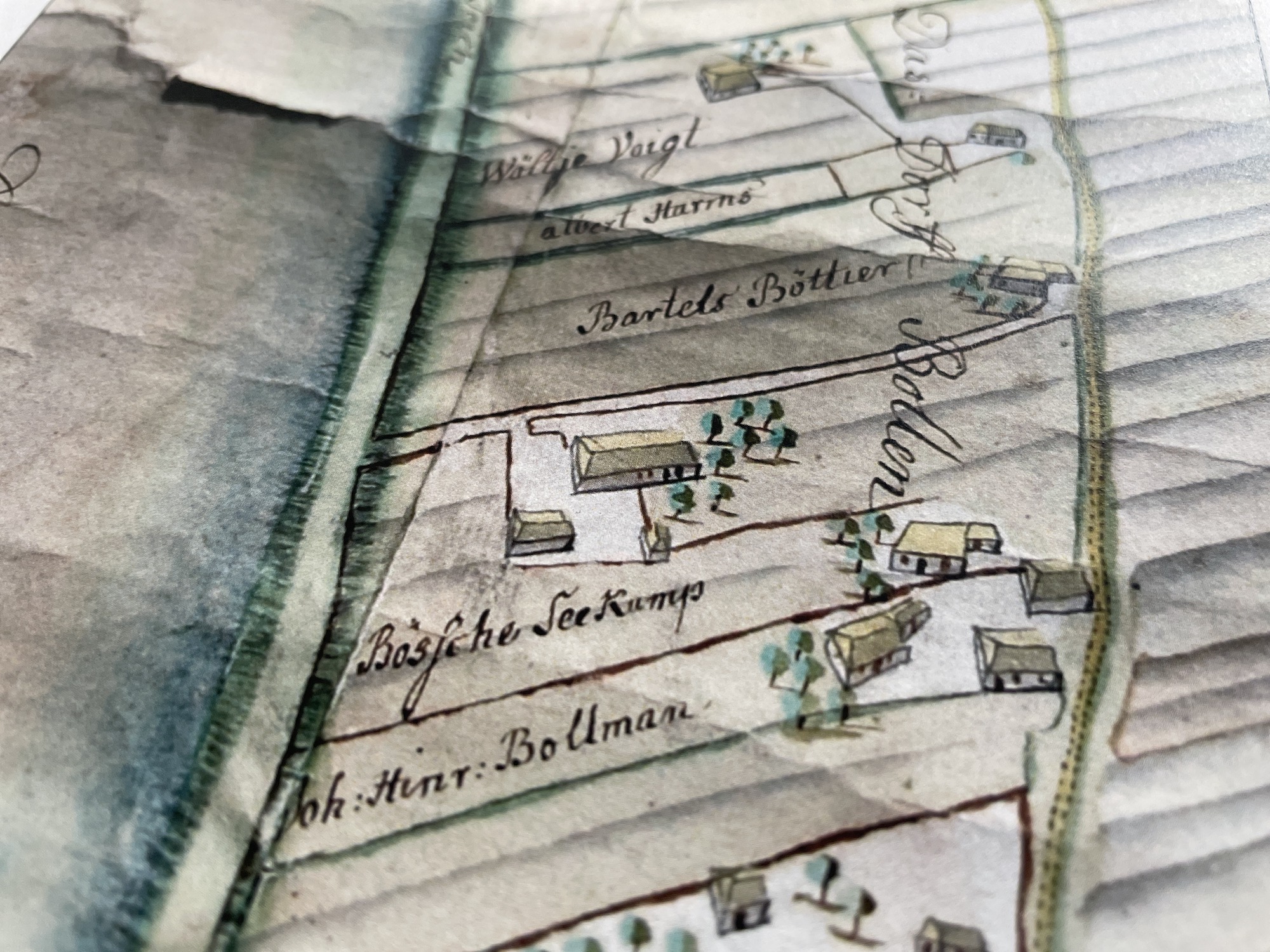
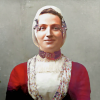

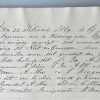



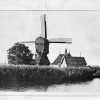

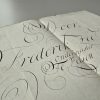
Thank you so very much for all of the Zee/Seekamp information you have published. I am so interested in your ancestral Zee/Bollen dialogue. I have so much to state but not enough space to thank you evermore for your knowledge. In 2011 and 2014 I visited Achim and Bremen, the town and citiy of my family Boesche and Anna Seecamp-Seekamp birth. Albert Seekamp emigrated to America in 1861 with his family; and they migrated to Louisville, Kentucky USA.